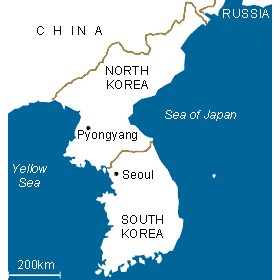PRESIDENT Kim Il Sung (1912-1994) is the saviour of the Korean nation, who liberated his country from the Japanese military occupation.
Crossing the Amnok River
In early February 1925, a boy was standing at a ferry on the 800km-long Amnok River that flows along the Korean-Chinese border. He was Kim Il Sung.
On learning that his father, who was fighting for the independence of the country in northeast China, had been arrested again by the Japanese police, he made a 400km journey from his native home in Mangyongdae to Phophyong, a Korean border village.
The thought that when he would come back if he left the country now caught his steps. The more he thought about it, the greater his hatred grew against the Japanese imperialists who had deprived the Koreans of their motherland and chased his father as far as northeast China to arrest him. With a firm determination that he would never return to his country before it became liberated, he crossed the river. His revolutionary career started in this way.
In October 1926, he formed the first revolutionary organization, Down-with-Imperialism Union. In December 1931, he put forward the line of launching an armed struggle against Japanese imperialism. And in April 1932, he founded the Anti-Japanese People’s Guerrilla Army (predecessor of the Korean People’s Revolutionary Army). Without any assistance from the home front or regular army, he struck the Japanese army and police with terror for over ten years, fighting against them in northeast China and the northern border areas of Korea.
Lighting the Torch for National Rebirth
In those days, Japan was intensifying its oppression and plunder of the Korean people to attain its aggressive ambitions. While shipping everything possible from Korea, it forbade the Koreans to use their language, both written and spoken, and forced them to change their names into the style of the Japanese.
It suppressed their anti-Japanese struggle by force of arms, and spread the false rumour that the revolutionary army had been annihilated. Korea turned literally into a living hell, and its people were living in a desperate situation.
At this time, in June 1937 Kim Il Sung, in command of a large unit of the Korean People’s Revolutionary Army, made a surprise attack on Pochonbo in Korea.
The Korean guerrillas destroyed or set fire on the Japanese ruling organs, and distributed an appeal among the local people.
Kim Il Sung made a speech in front of them, calling on them to turn out in anti-Japanese resistance full of confidence in sure victory.
After the battle, the guerrillas annihilated in Jiansanfeng the large Japanese forces that were in hot pursuit of them. By doing so, they demonstrated their great power.
In the wake of these battles, legendary tales that Kim Il Sung used the art of compressing space spread in Korea, in northeast China and even in Japan.
The battle of Pochonbo instilled in the Korean nation confidence that their country would be liberated without fail. Subordinate organizations of the Association for the Restoration of the Fatherland, a national united front body organized by Kim Il Sung, mushroomed and many armed units were formed for the final offensive against the Japanese imperialists in various parts of the country.
The name of Kim Il Sung became the symbol of hope and aspiration of all the Korean people.
Operation for Final Offensive for Liberation
In the closing days of the war in the Pacific, Japan regarded Korea as the “second theatre of decisive battle,” deployed many army units there, and plotted to make the war protracted.
Kim Il Sung put forward the strategic task for liberating the country through the general offensive of the Korean People’s Revolutionary Army combined with an all-people armed revolt, and ensured that full preparations were made for the operation.
On August 9, 1945, Kim Il Sung issued the order for general offensive for the liberation of Korea.
All the KPRA units broke through the “impregnable” areas on the Tuman River in high spirits, and advanced into the homeland.
The units, which landed in Korea in cooperation with the Soviet Army, liberated the areas of Rajin and Sonbong and advanced towards Chongjin.
The paramilitary units that had been waiting in the homeland for the day of final offensive turned out in an all-people revolt, supporting the advance of KPRA in every direction and liberating their areas by their own efforts.
On August 15 Japan declared unconditional surrender, and the history of 40 years of Japanese military occupation of Korea ended. This gave birth to a new Korea appeared on the international arena. []














